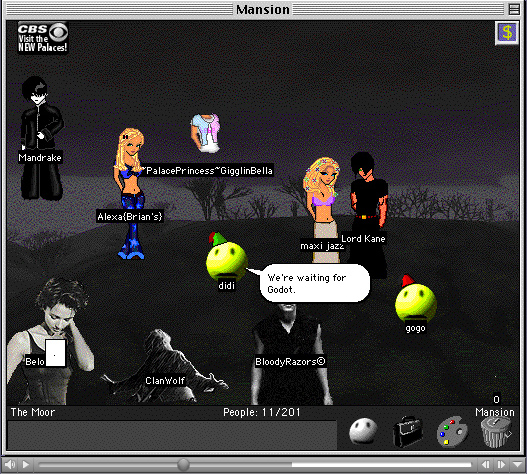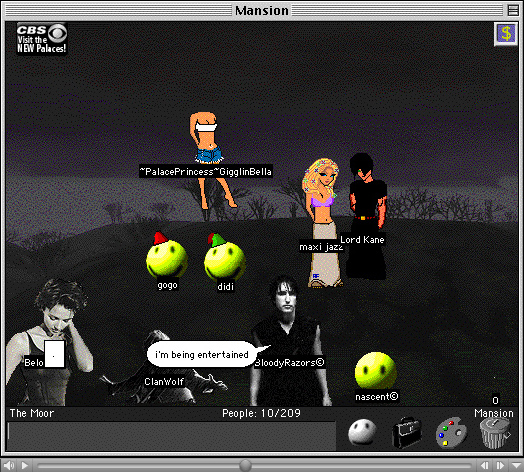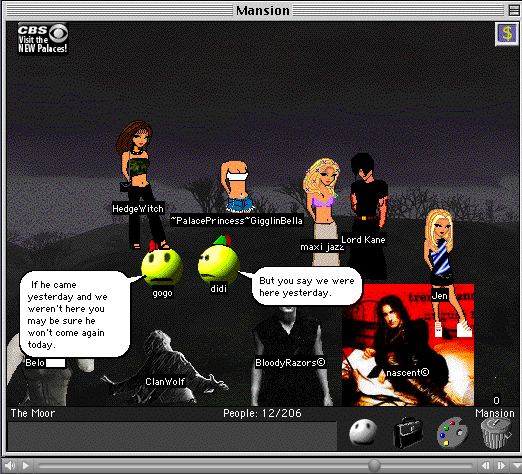[Status: Draft]
Related Categories: Text and Multimedia | Collective Reading
Summary:
Desktop Theater was initiated as an alternate form of Internet chat that took place in the popular 2-D avatar-based chat room called The Palace. Started in 1997 by Adriene Jenik and Lisa Brenneis, Desktop Theater sought to extend the metaphor of chat room-as-public-space to creating a type of “street theater” through the avatars in a public chat room on The Palace’s servers. Several “actors” meet at a preset time in an agreed upon locale in The Palace, each donning a specific avatar for the performance. They perform a specific dramatic text through a cut-and-paste method that displays the text in a bubble above the avatar’s head. Other chatters enter the scene and often engage the actors, becoming part of the performance, or create their own conversations in the mise-en-scène of The Palace chat room, contextualizing the performance as an online form of street theater.
Description:
Desktop Theater’s first online chat performance was the text of Samuel Beckett’s Waiting for Godot and was performed in a public room called “The Moor” in a chat room application called The Palace. Beckett’s modernist text involves two main characters, Vladimir and Estragon, who, like the avatars in the Desktop Theater version, arrive at a pre-arranged place to wait for someone named Godot to appear. The characters pass the time in conversation, yet Godot never makes an appearance. In the Desktop Theater version of this performance, Jenik and Brenneis fashioned two simple “roundhead” avatars (similar to IM smiley face emoticons) to play the roles of Vladimir and Estragon, now nicknamed “didi” and “gogo.” This online performance, which Jenik and Brenneis call “Street theater for the new Downtown,” is presented in a cut-and-paste fashion in which the actors take portions of Beckett’s text and paste it into their chat window. The text then appears instantly above their respective avatar in a comic book style text bubble. All of the chatted dialogue presented in The Palace appears in these bubbles, thus clearly associating dialogue with the avatar producing the dialogue. The dialogue is also “spoken” through the software’s text-to-speech capabilities simultaneous to its display on the screen. As Jenik notes:
We concentrated our efforts on the production values of a virtuosic cut-and-paste performance, literally copying the text form a text document, and quickly pasting it into the chat input window. Once input, the text appeared as if “spoken” from a speech bubble attached to the characters onscreen and was simultaneously “spoken” out loud, through the computer’s text-to-speech capabilities. Other chatters in the room would alternately comment on our presence, leave in confusion, or join the piece by trying to help us locate “godot” on the server. [1]
As the two avatars wait for Godot to appear in The Moor chat room, dialogue appears in a chat bubble above didi saying, “It’s Godot! It’s Godot! Gogo! It’s Godot! We’re saved!” This false alarm, as it is written in Beckett’s text, prompts another chatter who happens to be chatting in The Moor at the time (a user named Muscleman, who dons an avatar reminiscent of a “beefcake model straight out of a men’s underwear ad”) to respond, “Why are you waiting for him, anyway? I forgot” [2].

Desktop Theater was conceived out of Jenik and Brenneis’ interest in the “communicative potential inherent in…dynamic environments” such as “visual chat and game-centered online spaces.” Their work with online avatar-based chatting began with chatting experiments in the Massive Multiplayer Online Role Playing Game Ultima Online. The dynamics of character-based chatting in this environment, which is “fashioned by strict codes of genre and interaction,” severely limited the potential for a street scene to truly emerge. Thus, Jenik and Brenneis felt “doomed to inhabit a perpetual ghost world” since very few players would even respond to questions they would pose or even acknowledge their presence[3].

Turning exclusively to avatar-based chat rooms, Jenik and Brenneis began formatting dramatic texts for online communities, understanding these digital spaces as a ripe environment for a performative take on chat dialogue. After presenting waitingforgodot.com, the Desktop Theater troupe went on to perform texts based on other works of dramatic literature and adaptations, such as a piece titled, “Spectacled Society,” based on Guy Debord’s The Society of the Spectacle. The troupe’s next step was to create avatar-based improvisations, in which all of the actors were involved in a pre-planned structure or one actor would lead the narrative path as the others improvised around that actor’s promptings. As Jenik and Brenneis note on the Desktop Theater website: “In many instances our presence provoked passionate discussions of online performativity, identity and ethics” [4].

Research Context:
Desktop Theater’s research context bears on the various ways reading and writing take place in online chat room environments. Chat rooms vary in scope from the purely text-based chat environments to the increasingly popular VRML chat rooms that replicate a three-dimensional Cartesian space. While Desktop Theater is simply one example of the ways these online environments can be utilized, it offers an extremely rich avenue into the study of the relationship between chat dialogue and the conceptions of spatiality and embodiment that contextualize this online process of reading and writing. The study of Desktop Theater and the constantly shifting landscape of the chat room will offer greater insight into the ways online communities conceptualize digital space the communication that takes place in this space.
Technical Analysis:
All of Desktop Theater’s chat room performances were presented on The Palace chat servers: a 2-D graphical chat system that is downloaded to the user’s computer and hosted through many individually owned servers. This network connects servers that each host their own “palace”: a 512×384 pixel chat room that–in theory–can host over 200 avatars at a given time. Each room is set to a unique background image that becomes the theme of the room (such as waitingforgodot.com’s room called “The Moor”).
As users join The Palace, they may use one of the readily available avatars to represent their presence in the online chat space, or they may fashion their own avatar from scratch. The maximum size of the avatars at the time of Desktop Theater’s performances was 132×132 pixels. “In fact,” writes Jenik, “the preoccupation with avatars is a central topic for many chatters” [5].
Though several versions of 3-D and VRML chat environments were available for use a the time Desktop Theater began its performances, Jenik describes their decision to use a 2-D chat environment:
By choosing this software application (as opposed to a more graphically sophisticated 3D environment) we’ve made a commitment to using a free cross-platform application that works well within the constraints of limited bandwidth. No special cards, unusually large amounts of RAM, or massive hard drive allotments are needed to be part of Palace culture. All one needs is a Mac or PC (even an old one will do) with at least a 14.4 connection to the Internet to be able to be “seen” and “heard” in this densely populated online social space. Since chatting on the Palace is extremely easy to learn, it seemed like a perfect arena for experimenting with distributed narrative, especially since we wanted to work with writers and performers with histories (read: older) in other theatrical and literary communities. [6]
Unlike text-only chat rooms or VRML chat room (in which the text typically appears in a separate text window below or beside the VRML space), The Palace’s chat rooms display the online chat text strictly in bubbles stemming from the avatar. The text is thus spatially related to the avatar and scattered across the 2-D mise-en-scène of the chat window. This offers a unique object of study for an analysis of chat dialogue and the spatiality of online communities.
Evaluation of Opportunities/Limitations for the Transliteracies Topic:
Online reading, as demonstrated in Desktop Theater, moves beyond a simple relationship between reader and online text. Such text, as clearly demonstrated through the performative chat dialogues of Desktop Theater, is becoming more and more intrinsically connected to visual representations of authors/chatters and of the spaces these authors/chatters inhabit. Simultaneously, these authors are represented in the space as possible readers of the chat bubbles that appear in the public sphere of the chat room window. Thus, online reading is demonstrated as integrally related to the visual representation of space and the virtual community that inhabits this space.
The relationship between the avatar and the user in The Palace environment is one where the user constructs the avatar and places it on the stage to be viewed by other users and by the user herself. Jenik can see the roundhead avatar as it speaks her lines of dialogue. She can see the text bubble appear above its head, representing her actions in the online environment. Of importance to this study is the way the chatters’ avatars can be placed anywhere on the screen of the room, move about relationally with other avatars (thus conjuring notions of intimacy and proximity), and even leave the room at will.
The computer screen thus operates as an interface in which the user navigates and inhabits the virtual environment as a chat author/chat reader. The process of writing and reading in these chat rooms is a spatial process. It is also a process that always comes back to the source of the text: the avatar. Though the avatar the user creates may be a crude image seemingly unrelated to her material body, the mind of the user has created a referential link between the body at the keyboard and mouse to the body positioned on the virtual stage. Users in these virtual communities often make semiotic connections between the representation of the other users and the dialogue that is literally connected to these representations in the form of the chat bubbles. As Gregory Little notes,
Clearly these representations fulfill defining conditions of the avatar: they (1) are strap-ons for their users representing a corporeal individual’s presence in this or that space, (2) provide a source identity for the bubbles of text that emerge from them, (3) involve others in a guessing game with respect to the metaphorical or actual relationship between representer and represented. [7]
Though the visual representation of the chat room author/reader is a major concern for studies of visually-based chat rooms and virtual communities, it can be argued that the process of navigation in these environments can also be accomplished beyond the visual representations in the chat room. As seen in waitingforgodot.com, didi and gogo “search” the page for Godot, yet this act of navigation is done entirely in the text bubbles that hover over the avatars’ heads. The process of moving, searching, and even standing still as they wait for Godot is not completely mapped onto the physical movement of the avatars on the screen, but often takes place through textual representations of these movements. As Mark Poster says,
Participants are interpellated by each other, suturing identity in performatives, but the construction of the subject occurs entirely on the screen, determined entirely by the words entered on the keyboard. Participants are authors of themselves as characters, not simply by acts of consciousness, but by the interactions that take place on the screen. In these situations, the body, mediated by the interface of the computers and the communications network, enters a new relation with the subject, a dissociated yet actual relation that opens identity to new degrees of flexible, unstable determination. [8]
Thus, through the process of chatting–entering words into the chat window for viewers to respond to in a conversational way–spectator-users can navigate the chat room as a particular identity that may or may not be directly associated with an avatar. Perhaps it is through this process that spectator-users can create a distanciation between the “logo” of the avatar and the identity of the virtual subject navigating through cyberspace.
Resources for Further Study:
- Desktop Theater’s Website.
- Jenik, Adriene. “Desktop Theater: Keyboard Catharsis and the Masking of Roundheads.” The Drama Review 45.3 (2001).
- Little, Gregory. “A Manifesto for Avatars.” Intertexts 3.2 (1999).
- Poster, Mark. What’s the Matter with the Internet? Minneapolis: University of Minnesota Press, 2001.
Notes:
[1] Jenik, Adriene. “Desktop Theater: Keyboard Catharsis and the Masking of Roundheads.” The Drama Review 45.3 (2001): 99.
[2]Ibid., 97.
[3]Ibid., 96.
[4]http://leda.ucsd.edu/%7Eajenik/archive/files/a_fr_01.htm
[5]Jenik, Adriene. “Desktop Theater: Keyboard Catharsis and the Masking of Roundheads.” The Drama Review 45.3 (2001): 97.
[6]Ibid., 98.
[7]Little, Gregory. “A Manifesto for Avatars.” Intertexts 3.2 (1999): 196.
[8]Poster, Mark. What’s the Matter with the Internet? Minneapolis: University of Minnesota Press, 2001, 75.
